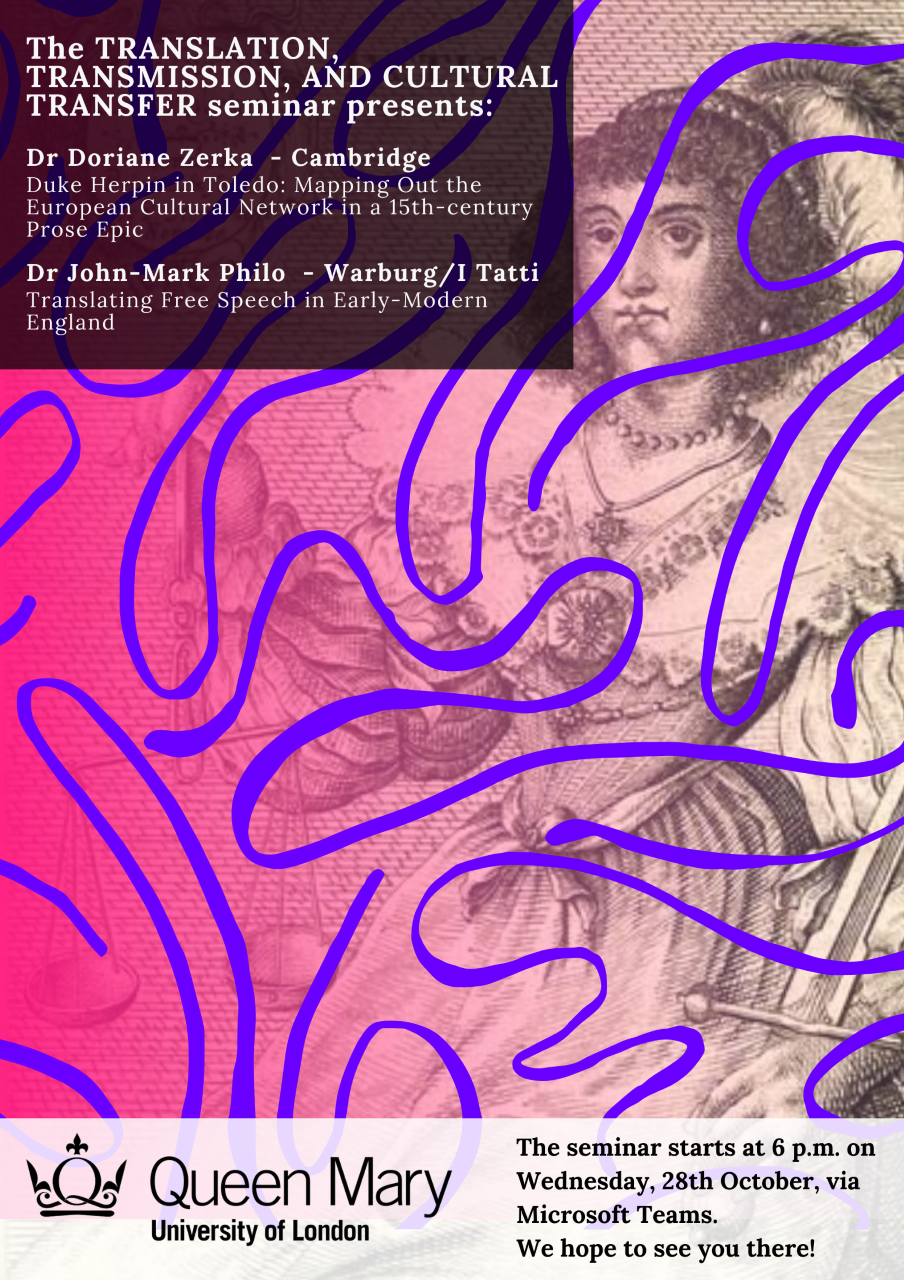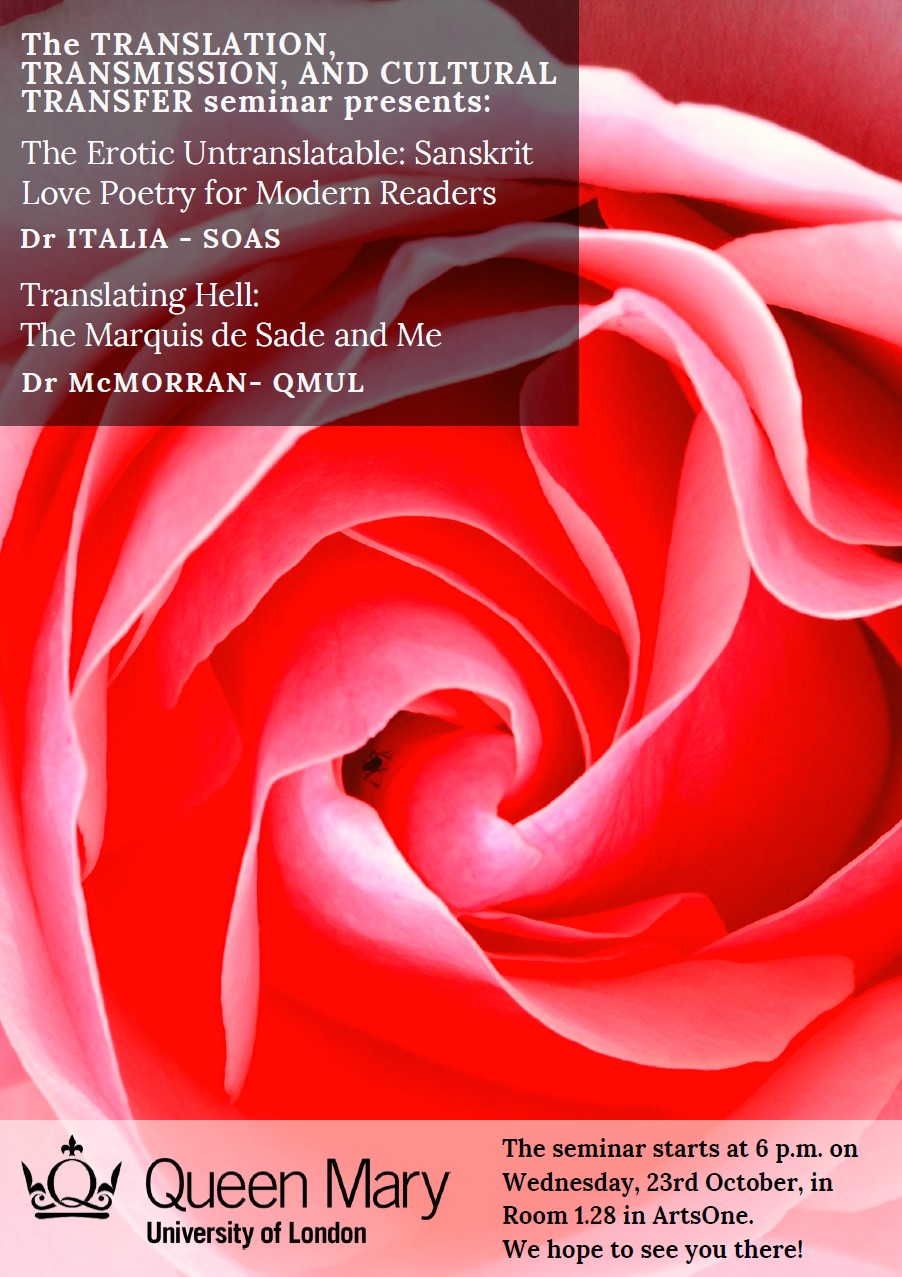Translation, Transmission, and Cultural Transfer
Joint research seminar for Modern Languages and Comparative Literature

This seminar series aims to create a space for conversations about translation in the widest sense of the word – translation as an encounter between two or more cultures as well as languages, and translation as the cultural transmission of concepts as well as words. We are interested in questions of translation history (historical translators; translation practices and cultures), methodology (developing new approaches at the interstices of literary, historical, cultural, and linguistic studies), theory (engagement with theorists from Cicero and Bruni to Steiner and Venuti; interaction with other theoretical foci such as gender, race, medical and environmental humanities; new developments in theorisations of multicultural and multilingual translations), and the specific translation cultures of any given language or language environment. We are hoping to promote dialogues between scholars working on different languages, between theorists and practitioner-based research, and across the wide world of cultural engagements in history from ancient Greece to contemporary dialects.
In addition to traditional research papers, we welcome works in progress as well as novel approaches to engaging with scholarly research: explorations of research-informed teaching or teaching-informed research on translation, discussions on accessing and using digital resources, and bringing Translation Studies to a wider audience through public engagement activities.
We are delighted to announce that the QMUL research seminar on Translation, Transmission, and Cultural Transfer will be starting again at 6 p.m. on Wednesday 28th October, 2020, via Microsoft Teams. You are very welcome to join us: please email seminar organisers Angela Dorado-otero (a.dorado-otero@qmul.ac.uk) and Richard Huddleson (r.w.huddleson@qmul.ac.uk) for the session links.
28th October 2020 - Dr Doriane Zerka (Cambridge) and Dr John-Mark Philo (Warburg Institute/The Harvard University Center for Italian Renaissance Studies, Florence)
Duke Herpin in Toledo: Mapping Out the European Cultural Network in a 15th-century Prose Epic
In the fifteenth-century German prose epic Herzog Herpin, the city of Toledo holds a symbolic function as a node linking the multiplicity of networks that criss-cross the text. As characters separate and move around the Mediterranean basin, Toledo acts as a narrative node in the construction of a Mediterranean network – a node in which characters are reconnected and the initial conflict of the text is resolved. Simultaneously, Toledo functions as a locus of literary traditions, a place in which inter-textual references bring to light the extra-textual “European” cultural network in which the epic is located.
Dr Doriane Zerka, previously Lecturer in German at QMUL and now a Leverhulme Early Career Fellow at the University of Cambridge, working on the role of women as transcultural agents in premodern European literature.
Translating Free Speech in Early-Modern England
In around 1600, Robert Peterson, attorney and translator, completed his translation of one of the most detailed discussions of free-speech to have emerged from the early-modern period: Claudio Tolomei’s discourse on ‘la libertà del parlare’. The translation, which survives in a single manuscript copy, speaks of the intense interest around free speech and its regulation in the final years of Elizabeth’s reign, as well as wider English engagements with Italian culture and political thought more generally. This talk explores the tools with which Peterson undertook his translation, including a French intermediary, and highlights the discourse's points of contact and contrast with contemporary English debates concerning free speech.
Dr John-Mark Philo, previously a postdoctoral researcher at University of East Anglia working on the Tudor reception and translation of Tacitus, currently working on a joint research between the Warburg Institute and The Harvard University Center for Italian Renaissance Studies Villa I Tatti in Florence.
11th December 2019 - Dr Alisa van de Haar (Leiden) and Professor Adrian Armstrong (QMUL)
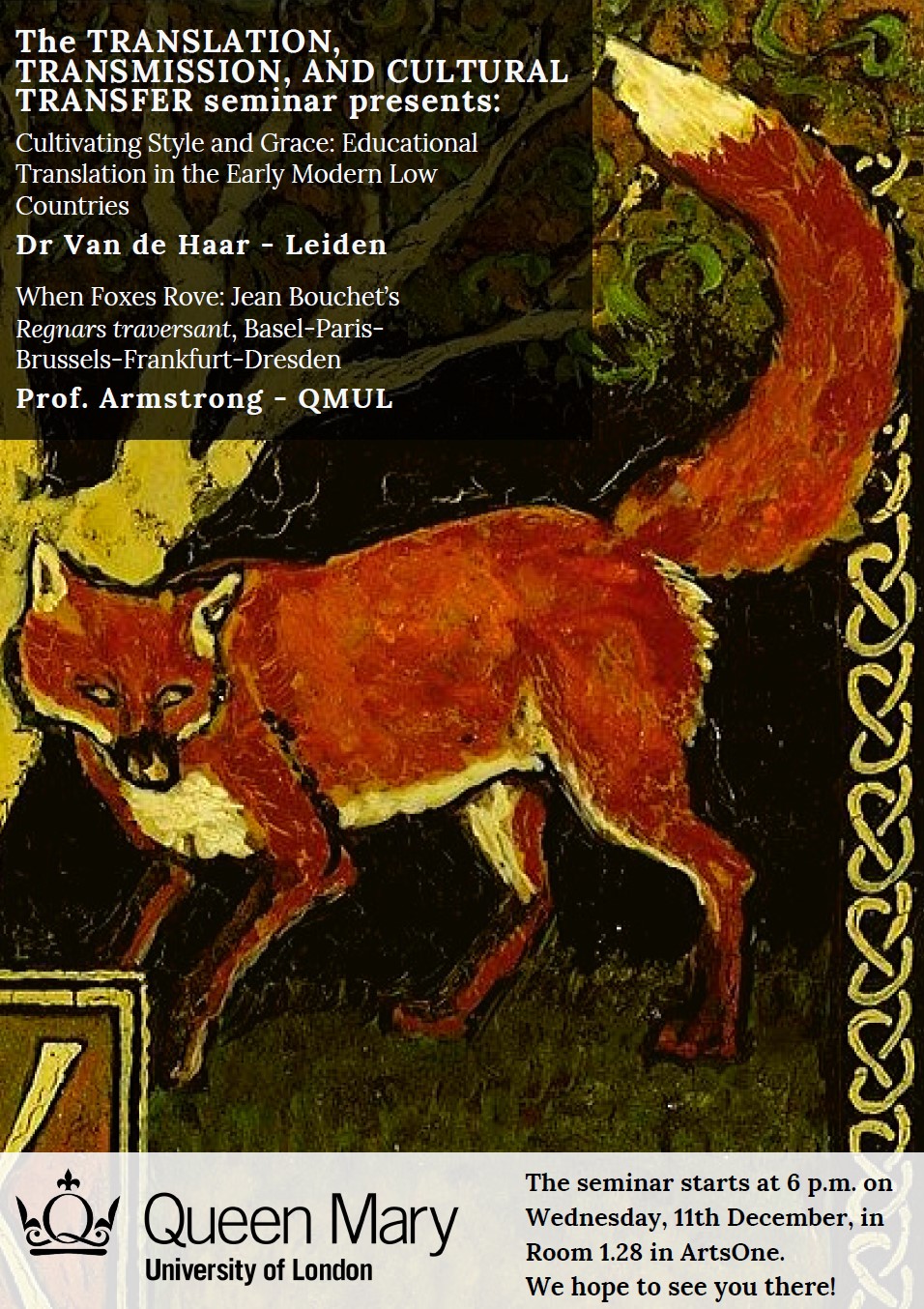
Cultivating Style and Grace: Educational Translation in the Early Modern Low Countries
In the sixteenth-century Low Countries, a new type of educational institution arose, aimed at teaching French to the sons and daughters of the middling classes. In these French schools, translation exercises were a frequently used tool for language education. Students translated sample dialogues, lists of proverbs, and popular stories such as those on Reynard the Fox, which were presented in bilingual books that had been specially designed for this purpose. While all schoolmasters agreed on the usefulness of translation as a teaching method, there was a lack of consensus on the form of translation that was most helpful for language learning: word for word or sense for sense translation. Schoolmasters on either side claimed that their preferred form of translation helped the students to not only learn French, but to also train rhetorical ideals such as style, grace, and eloquence in both the second language and the mother tongue. This paper will present both sides of the debates and show how translation was used as a means for cultivating style and grace in Dutch and French.
Dr Alisa van de Haar, Centre for the Arts in Society at Universiteit Leiden
When Foxes Rove: Jean Bouchet’s Regnars traversant, Basel-Paris-Brussels-Frankfurt-Dresden
Jean Bouchet’s Regnars traversant – first published in Paris c.1503 with a fraudulent attribution to Sebastian Brant – poses edifying interpretive challenges to its readers. Its governing metaphor, the fox as an image of human vice and dishonesty, is developed through a set of enigmatic woodcuts that depict the narrator’s visions, and that must be deciphered in conjunction with the accompanying text. Various motifs in the woodcuts derive from a 1497 broadside by Brant, published in German (and probably also in Latin). The Regnars’ distinctive illustrations, and its combination of prose and verse, were no obstacle to further publication across linguistic, and sometimes confessional, boundaries. In 1517 Thomas van der Noot printed a Dutch version, De loose vossen der werelt, which he had probably translated himself. The Loose vossen was itself translated into High German as Von den losen füchsen dieser welt; the Frankfurt printer Hermann Gülfferich published two editions in 1546. Sixty years later an unlocalized edition appeared with copies of Gülfferich’s images, some of them reversed. Matthes Stöckel published a revised edition, with a more pronounced Lutheran orientation, in Dresden in 1585. The successive translations and revisions are illustrated by increasingly elaborate woodcuts, and adopt different approaches to translating or presenting verse. I examine the ways in which text-image interactions evolve as the Regnars travels eastward, as well as the shifting configurations of verse forms and their meanings. The interplay of conservation and intervention across Dutch and German versions encourages reflection on what analytical tools might best elucidate the cross-cultural transmission of complex multimodal texts in early modern Europe.
Professor Adrian Armstrong, Centenary Professor of French Deputy Dean for Research (PGR), QMUL
23rd October 2019 - Dr Will McMorran (QMUL) and Dr Italia (SOAS)
Translating the Erotic
Translating Hell: The Marquis de Sade and Me – Dr McMorran
Is translation an act of masochism? This paper will explore some of the challenges - linguistic, ethical, hierarchical, physiological - I faced when translating and editing Sade’s The 120 Days of Sodom with Tom Wynn. It will explore some of the uncomfortable questions of complicity Sade’s novel poses the reader, let alone the translator, and reflect on translation as an affective, and affecting, experience. There will be violence, obscenity, and puns.
The Erotic Untranslatable: Sanskrit Love Poetry for Modern Readers – Dr Italia
Since the late eighteenth century, with the surge of a kind of ‘Indomania’ among Western literati, Sanskrit erotic poetry has experienced an uninterrupted popularity in Europe and North America. Yet, the first Latin versions and erudite commentaries of such poetry soon led way to a proliferation of first- and second-hand translations, chiefly by poets or translators of ‘Eastern poetry’ who had no direct acquaintance with Sanskrit. Unsurprisingly, anthologies of Sanskrit erotic poetry also contained forged verses, often racy or titillating, which were effectively smuggled as literary expressions of ‘Eastern love’. In parallel with the re-translation, pseudo-translation and adaptation of Sanskrit erotic poetry, another intriguing phenomenon that we witness is the ‘rebranding’ of earlier ‘high-brow’ translations as erotic curios. What is more, these translations could even be retouched to make their erotic suggestiveness more explicit.
In my talk I will focus on a little volume “strictly reserved to subscribers” published in Paris in (probably) 1914 as part of the series “Le coffret du bibliophile”, which, together with the series “Les maîtres de l’amour”, was the brainchild of the Briffaut brothers, the founders of the clandestine publishing house Bibliothèque des curieux. The complete title of the volume reads Anthologie érotique d'Amarou suivie des sentences érotiques de Bhartrihari et de contes orientaux [“Amaru’s erotic anthology followed by Bhartṛhari’s erotic sayings and Oriental tales”]. In fact, the volume contains not only a reprint of the (erudite, yet flowery) Anthologie érotique d’Amarou by Antoine-Léonard de Chézy (1831), but also of Hippolyte Fauche’s equally learned translations of Bhartṛhari’s Śṛṅgāraśataka and Bilhaṇa’s Caurapañcāśikā, originally published in 1852.
To ‘spice up’ Chézy’s and Fauche’s sometimes reticent and euphemistic prose, the editor(s) of this volume added sexually explicit details to the original translations and exegetical notes. In a few instances, the translations were ‘retouched’ to such an extent that the sense of the original Sanskrit stanzas was not simply made more explicit, but completely distorted. Hence, the primary aim of my talk is to show how the Briffaut brothers’ editorial rebranding of Sanskrit erotic poetry is not only a testament to the paradoxical ‘portability’ of Chézy’s and Fauche’s erudite translations: it also bears witness to a persistent desire to treat ‘exotic’ erotic poetry as a locus to articulate the Western readers’ own Orientalist projections and erotic fantasies.
25th September 2019 - Dr Ben Holgate (QMUL) & Dr Alexander Bubb (Uni Roehampton)
“Translating Chinese Texts Over Time, from the Victorian Age to the New Millennium”
29th May 2019 - Dr Victoria Moul (KCL)
‘Why Latin? Verse Translations from Vernacular into Latin in the Seventeenth Century’.
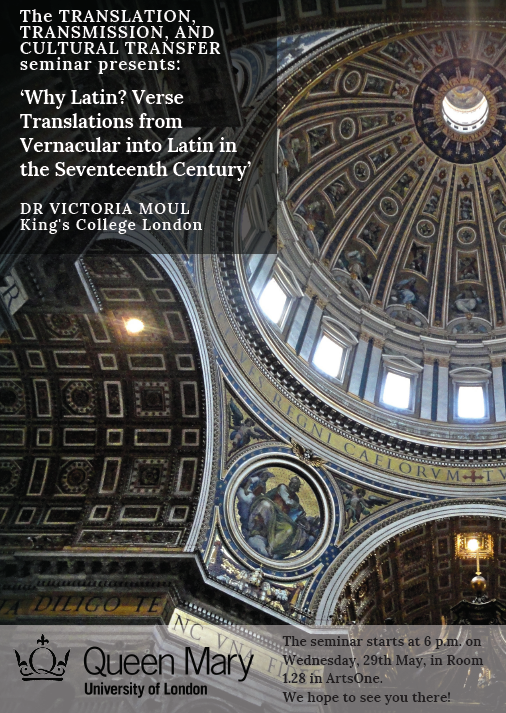
Room: ArtsOne 1.28
Time: 18:00
The literary culture of seventeenth century England was bilingual, with significant consumption and production of verse in two languages above all: that is, in English and Latin. The literary bilingualism of this period is particularly visible in surviving manuscript sources - ranging from scribal presentation copies to personal notebooks and letters. Drawing on the findings of a large Leverhulme funded project on Latin verse in manuscript sources, as well as on print culture, this paper will explore one particular facet of seventeenth-century literary bilingualism: namely, the phenomenon of verse translations from vernacular languages (especially English, but also including French, Dutch and Italian examples) into Latin. Examples range from topical and satiric epigrams through to Latin translations of the work of major authors, such as Du Bartas, Milton and Cowley. The paper will aim to give an overview of this material, and also the questions it raises about what literary translation, and Latin verse, were “for” in seventeenth century England.
24th April 2019 - Dr Elettra Carbone (UCL)
'Mapping Nineteenth-Century Scandinavia: Edward Price’s Norway and Henry Clark Barlow’s Denmark'.
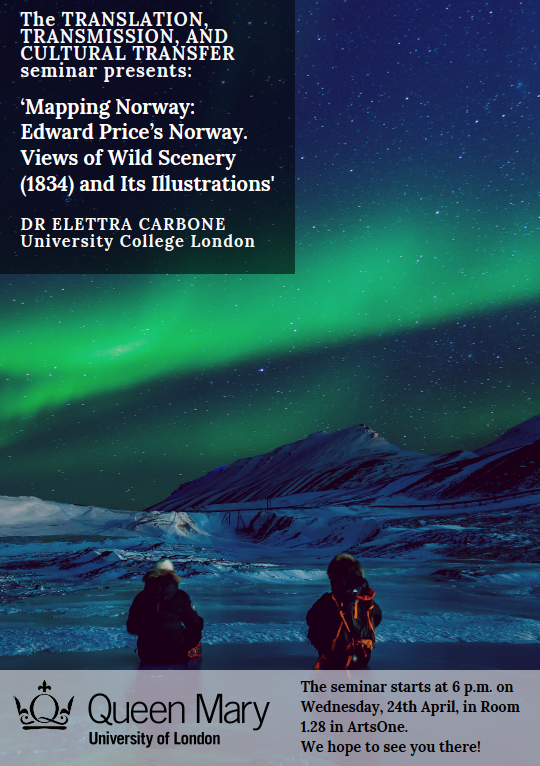 Room: ArtsOne 1.28
Room: ArtsOne 1.28
Time: 18:00
From the end of the eighteenth century, Norway became an increasingly popular destination for British travellers in search of ‘a new and intriguing alternative to the more well-trodden paths’ (Fjågesund and Symes 2003: 39). The artist Edward Price (1800-1885) is today all but forgotten, but his major enterprise, a journey to Norway in 1826, remains immortalised in his illustrated journal Norway. Views of Wild Scenery. The seven engravings of Norwegian landscapes that are today part of the UCL Art Museum’s collections were made by the British painter and engraver John Linnell, The Elder (1792-1882) after drawings by Price but were not used as illustrations when Price’s book came out in 1834. The book included, instead, 21 engravings by the British artist Davis Lucas (1802-1881). Later Thomas Forester (dates unknown), who visited Norway in 1848, included Price’s journal in his Norway and Its Scenery (1853) and made use of the same engravings by Lucas.
Drawn to Norway by ‘the promise of a superabundance of material’ for his pencil, Price makes a number of references to his sketches and the process involved in their creation. Together, the text and the illustrations ‘map’ Norway, as they construct and communicate spatial knowledge of a region that was still little known to the British reader (Cosgrove 2012: 1). In my paper I will explore the relationship between Price’s written account, often focusing on the difficulties of the journey as well as the dramatic nature of the Norwegian landscape, and the two sets of engravings by Linnell and Lucas. What made Norway an exceptional motif for Price?
20th March 2019 - Professor Theo Hermans (UCL)
‘How to Write Translation History?’.
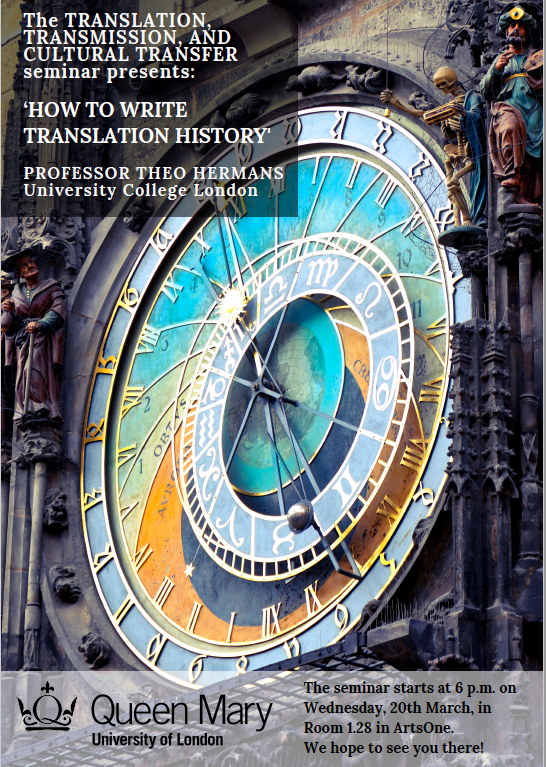 Room: ArtsOne 1.28
Room: ArtsOne 1.28
Time: 18:00
Translation history received only intermittent attention in past decades but is currently popular again. Several substantial historical surveys have appeared in recent years, including some multi-volume works. Methodological reflection, however, has lagged behind; although various scholars have addressed individual issues in a range of essays, the only book-length treatment in English dates from twenty years ago. In the seminar I will begin by setting out my own stake in this discussion, before going into some of the standard questions concerning periodization, agency and the possibility of a transnational translation history. The main part of the seminar will involve an invitation to think about the relation between translation and history in more comprehensive terms. Perhaps the history of translation is the easy part? What about the translation of history? How much history is there in individual translations, and how do we tease it out? In thinking about the historical significance of translation, are we thinking primarily about history or about translation? The aim is to address questions like these interactively.
27th February 2019 - Dr Ricarda Vidal (KCL) and Dr Madeleine Campbell (Glasgow)
‘The Translator's Gaze: Intersemiotic Translation as Transactional Process’.
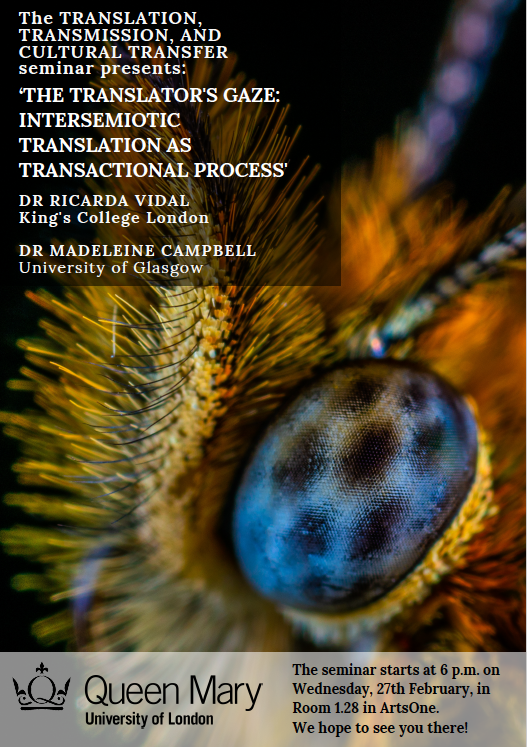 Room: ArtsOne 1.28
Room: ArtsOne 1.28
Time: 18:00
23rd January 2019 - Dr Marta Marfany (Pompeu Fabra University Barcelona)
‘Translating into Catalan 19th-Century French Texts in Prose: Charles Baudelaire and Théophile Gautier’.
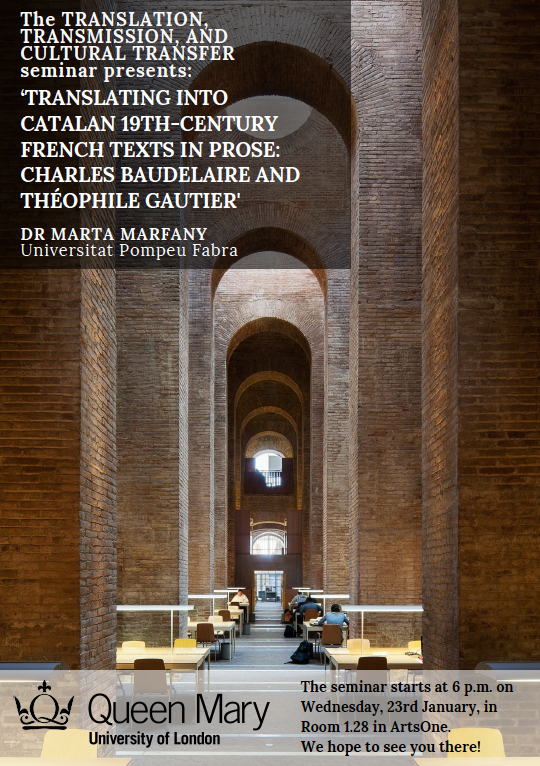 Room: ArtsOne 1.28
Room: ArtsOne 1.28
Time: 18:00
Abstract
The friendship between the two French writers Théophile Gautier (1811-1872) and Charles Baudelaire (1821-1867) is well known. In 1859 Charles Baudelaire published a biography of his friend and inspiration Théophile Gautier. Years later, on the death of Baudelaire, Théophile Gautier reciprocated by writing a biography to introduce the posthumous edition of Baudelaire’s complete works (1868).
In this seminar I will present both biographies, which I am translating into Catalan, for publication in a volume along with other works by these authors. I will explore the main translation challenges posed by these texts, especially those that arise from the chronological gap between the original texts’ mid-nineteenth- century French writers and the twenty-first-century Catalan readers. This historical and cultural distance has repercussion for the translation process. The translator must reproduce the flavour of the language and reconstruct cultural codes that are practically unknown by today’s readers.
Some of the translation solutions that I suggest are of course not restricted to Catalan but can be applied to translation into other languages.
12th December 2018 - Dr Rachel Scott (KCL)
‘Translating an Oriental Frame Tale in Medieval and Early Modern Iberia and Beyond’.
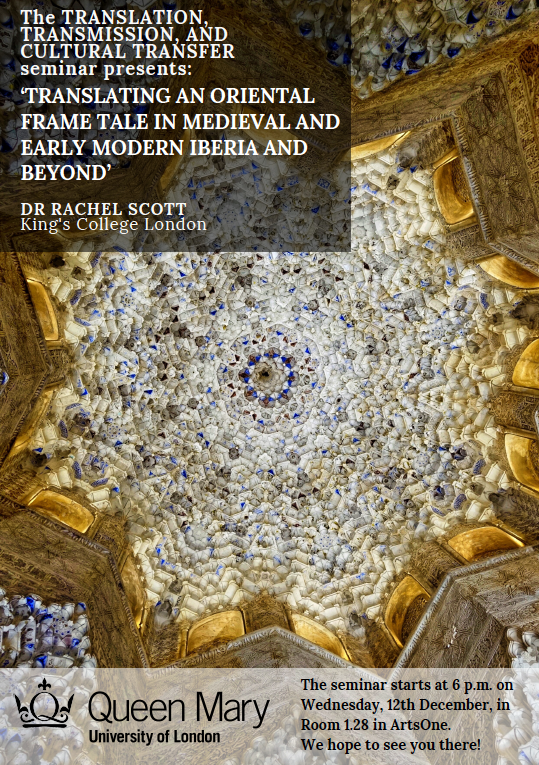 Room: ArtsOne 1.28
Room: ArtsOne 1.28
Time: 18:00
Abstract
This talk will address several of the medieval and early modern translations of Kalila wa-Dimna – a famous Arabic collection of exemplary fables set within a framed narrative. Kalila wa-Dimna was composed in the 8th century by Ibn Al-Muqaffa, a convert to Islam, and was itself a translation of a translation that originated in 4th-century India, known as the Panchatantra. My research takes it cues from scholarship that has conceptualised translation as a political and ontological act of identity formation. I am concerned not with translation techniques but translation as a form of intercultural encounter, as a means of dealing with a culture/society’s relationship with the Other, with its own past and heritage, and constructing an identity for itself in the present. I see translation as a form of storytelling, ultimately. I consider Kalila wa-Dimna and the texts that descend from it as case-studies of relations between cultures, particularly on an East/West axis. My aim is to explore how perceptions of the ‘Orient’ evolved, and how cultural forms and practices that originated in the East were appropriated and in turn used to define social and national groups in western Europe.
14th November 2018 - Dr Cathy McAteer (Bristol)
‘Red Books and Russian Agents: Behind the Scenes at Penguin's Russian Classics’.
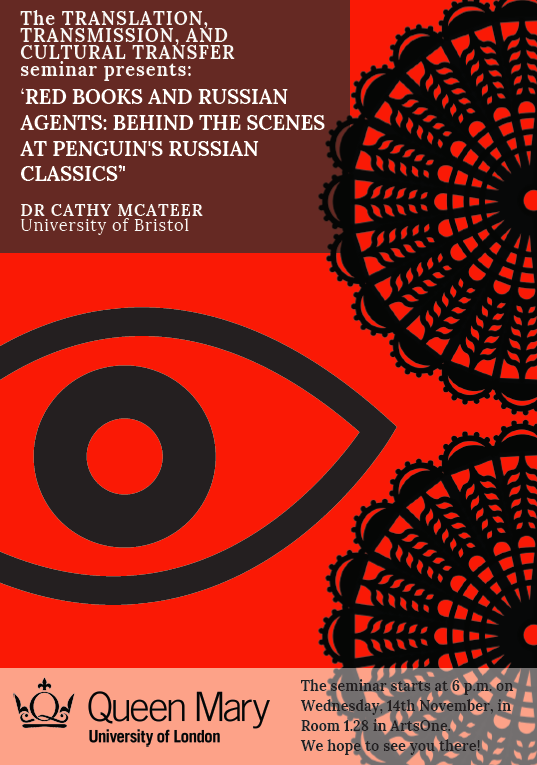 Room: ArtsOne 1.28
Room: ArtsOne 1.28
Time: 18:00
Abstract
This paper examines Penguin’s twentieth-century re-launch of the nineteenth-century Russian literary canon. Drawing on previously untapped archival material (letters, memos, readers’ reports, reviews, adverts), this paper reveals a previously undisclosed ‘behind-the-scenes’ look at Russian-English literary translation in the mid-twentieth century. It offers new insight into Penguin Classics luminaries: Penguin founder Allen Lane, the editors EV Rieu and ASB Glover, and the early translators Elisaveta Fen, David Magarshack and Rosemary Edmonds, whose work also enjoyed frequent airings on national stage and in BBC Third Programme broadcasts. I will examine how these agents pooled their expertise and abilities to bring an accessible form of Russian literature to the mass lay reader. I will be drawing on archive- and text-based materials – a micro-historical approach, as advocated by Jeremy Munday – to explain how translators’ personal/professional backgrounds shaped their translation practice and, in doing so, determined the Anglophone reception of classic Russian literature for almost half a century.
24th October 2018 - Dr Adhira Mangalagiri (QMUL)
'Unfriendly Comparison: Antagonism in China-India Literary Relations'.
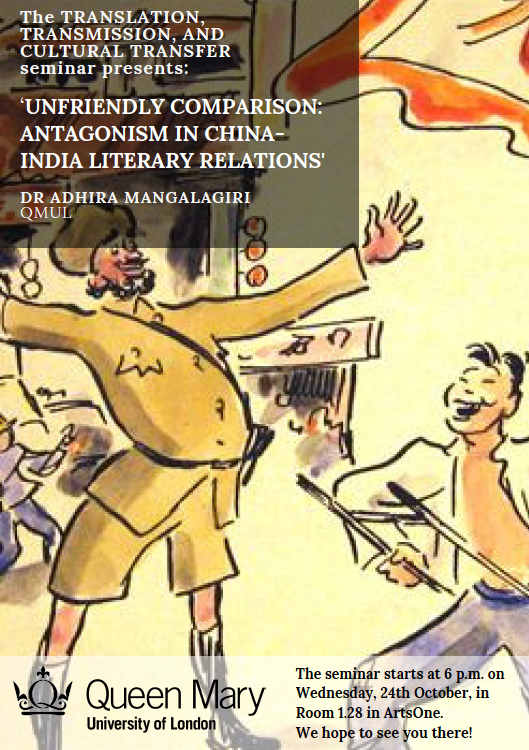 Room: ArtsOne 1.28
Room: ArtsOne 1.28
Time: 18:00
Abstract
Comparative Literature excels at studying connection, dialogue, exchange, translation, and other positively-valued modes of relation. In contrast, this paper questions whether the method of comparison can be harnessed to study “unfriendly” relations such as hostility, tensions, anxieties, and the absence of dialogue and exchange. I explore this question through the case of twentieth-century China-India literary relations. Reading Chinese and Hindi texts, I consider how comparative methods can sustain and apprehend antagonism on its own terms instead of aiming to resolve or erase conflict.
26th September 2018 - Dr Roel Konijnendijk (University of Leiden)
‘Reading Clausewitz to Understand Thucydides: Prussian Militarism and the Modern Study of Ancient Greek Warfare’.
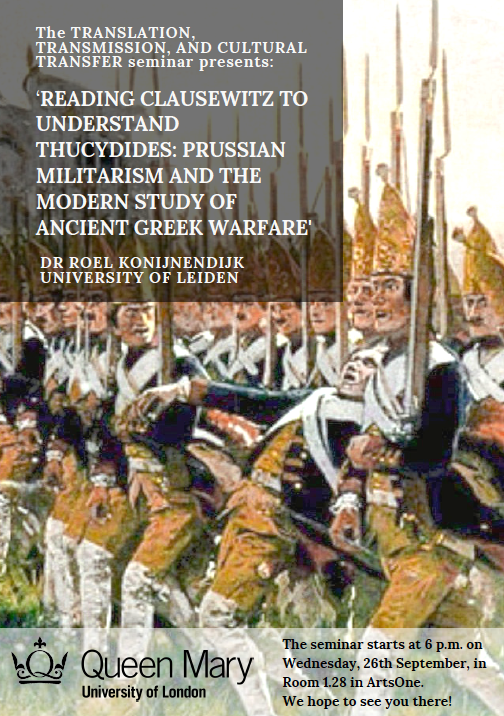 Room: ArtsOne 1.28
Room: ArtsOne 1.28
Time: 18:00
Abstract
The earliest academic experts in the field of Ancient Greek military history were Germans with often close ties to the military, and they studied the subject from a very particular perspective. They understood warfare through the lens of Prussian professionalism, the military academy, and 19th-century technology. But the Greeks they studied were amateurs, who had no professional army or officer class or military theory. The result is that these German scholars felt compelled not just translate and interpret sources from Greek to German (and, in the case of their Anglophone successors, from Greek to English), but to translate them from the imprecise and open-ended language of the citizen-soldier to the specific terminology of modern military textbooks. An important element of the way we now (mis)understand Greek warfare is this distortion that lies at the foundation of all our theories.
